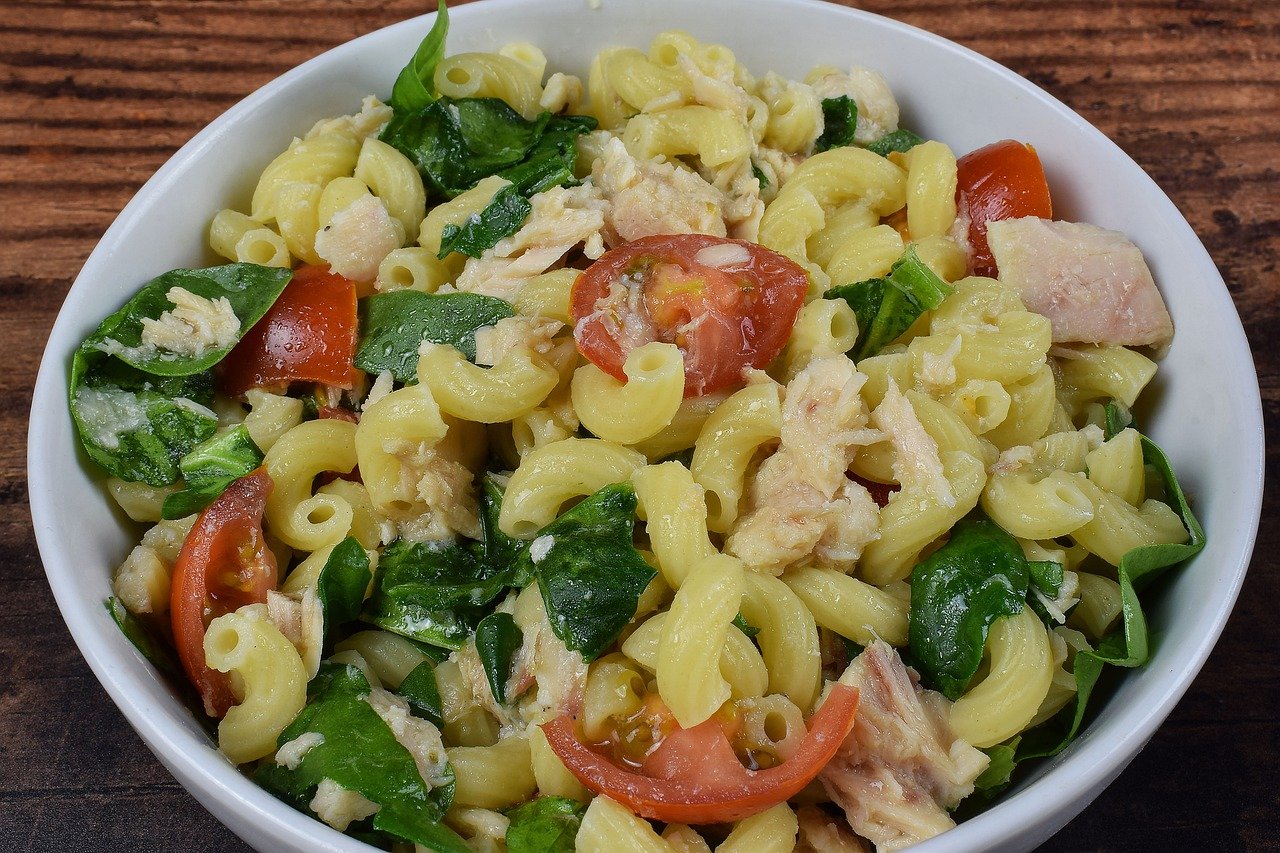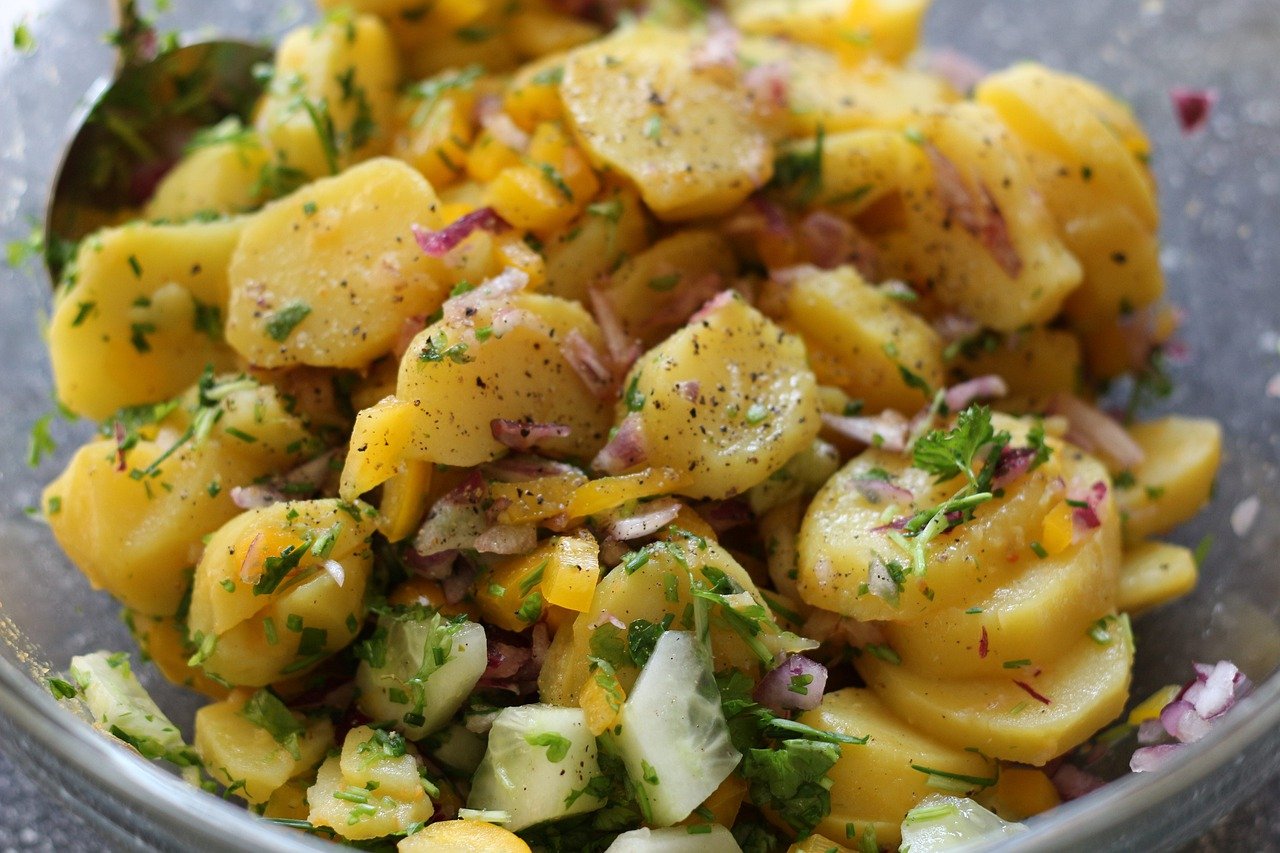As a low-calorie meal or side dish, a salad is likely to come to mind first. However, salads’ caloric content can vary widely due to many salad ingredients, garnishes, and dressings to choose from.
What you put in your salad affects the number of nutrients it contains. Toppings may transform a simple dish into one rich in protein, good fats, the correct carbohydrates, and various essential vitamins and minerals.
However, more fat, sugar, sodium, and calories might be included in other ingredients. If you choose wisely, it is possible to put together a tasty, healthy salad.
Because they contain no fat or cholesterol but are packed with nutrients like fiber, vitamin C, and potassium, potatoes are a healthy choice. In addition, veggies and herbs, including celery, onions, carrots, parsley, dill, and basil, are frequently included in potato recipes.
However, the addition of mayonnaise, sauces, and even bacon can make potato salad a little heavier. Per cup, you’re staring at a calorie and fat count of almost 420.
Pasta can take on any taste you want, and vegetables and herbs have plenty of room to shine. This dish can be hefty or light, depending on the added component.
Croutons and bacon bits from the grocery store are salty and nutritionally devoid. Cheese is a good supply of calcium, but each ounce includes about 100 calories.
Thanks to the sauces, the macaroni salad can easily reach 600 calories and 40 grams of fat. On the other hand, traditional macaroni salad dressings frequently contain added sugar. Just one cup of cooked pasta contains about 200 calories.
Why Is Macaroni Salad Unhealthy?

In contrast to other salads, Macaroni salad tends to be high in calories. Therefore, you should always check the nutrition information label before eating macaroni salad if you’re concerned about calories and fat.
Elbow macaroni, mayonnaise, onions, celery, peppers, and pickles are all common ingredients in this salad. Compared to other mayo-based salads, macaroni pasta salad is lower in protein and higher in carbohydrates.
Carbohydrates are a significant component of macaroni salad. It contains 53 grams of carbohydrates, 3 grams of fiber, and a gram of sugar per serving of macaroni and cheese salad. However, because it includes only 9 grams of protein, macaroni salad is not an excellent source of this macronutrient.
What’s Worse for You: Pasta or Potato?
The more complex carbs found in potatoes, according to some nutritionists, make them a better alternative to pasta. But, on the other hand, potatoes and pasta are both high in complex carbs, which should be the foundation of any healthy diet.
As always, moderation is the key. Aside from monitoring your carbohydrate intake, you must also pay attention to the kind of foods you eat with your bread, pasta, rice, or potatoes and the cooking methods you use.
Integral varieties with more fiber are also a good option, as they assist in speeding up intestinal transit, reduce constipation, and provide a more wonderful feeling of fullness.
There should never be a diet without complex carbs. As a result, your blood glucose levels remain consistent, and you are less likely to experience debilitating “hunger episodes.”
Because of this, it’s important to remember that the cooking method you use will have a significant impact on how many calories you consume and how your body processes the nutrients you ingest from these foods.
Despite the high carbohydrate content of pasta and potatoes, cutting them out of your diet is not recommended, especially if you are trying to slim them down. On the contrary, they should be included in the ideal situation, but sensibly. The occurrence of many diseases can be reduced by eating a well-balanced diet.
You don’t need to exclude carbohydrates from your diet because they give the same number of calories as protein and fewer than fat. Instead, you should eat more whole grains, legumes, veggies, fruits, and less refined goods like sugar.
What Are the Benefits of Eating Macaroni Salad?
Pasta is an excellent base for a balanced dinner that’s also filling. This is because glycogen, the brain and muscle fuel derived from carbohydrate sources like pasta, is provided by pasta carbohydrates.
In a healthy diet, pasta is one of the many food groups that can be found in addition to grains like wheat and barley. It’s a good energy source and can give you fiber, too, if it’s made from whole grain.
When it comes to feeding a family, spaghetti is an excellent option that doesn’t break the pocketbook. Flour, water, salt, and perhaps a few eggs are the only necessary components.
Here are the ways to improve the nutritional content of your macaroni salad:
- Use whole-wheat pasta for your salad: Adding fiber doesn’t increase the caloric content, but it makes you feel fuller longer, decreasing your likelihood of eating another serving. To keep the pounds off, skip the second serving. The fiber content of a regular macaroni salad is only one gram.
- Add vegetables to your pasta: Macaroni salads tend to be a little lacking in vegetables. Celery and chopped onion may be included in this dish. Edamame, spinach, and carrots offer a healthier profile compared to the usual celery and onion.
- Do not limit yourself through mayonnaise: The mayonnaise-based creaminess of a macaroni salad is arguably the most significant component of the dish. Instead of using full-fat mayonnaise, you use low-fat mayo and sour cream.
How Many Calories Are in a Macaroni Salad?
Three hundred seventy-three calories can be found in a single dish of macaroni salad. If you eat 2,000 calories a day, this will account for roughly 19 percent of your daily caloric intake.
One cup of macaroni salad has roughly 7 grams of fat. Saturated fat, which is found in full-fat mayonnaise, can raise your risk of heart disease when consumed in large amounts.
- The digestion of pasta is greatly influenced by the method used to cook it. Therefore, pasta’s calories will behave differently depending on the cooking method used.
- The pasta is considered al dente if it provides some resistance when being bitten. As the starch molecules aren’t broken down, digestion is a little more sluggish, and energy release is more gradual.

